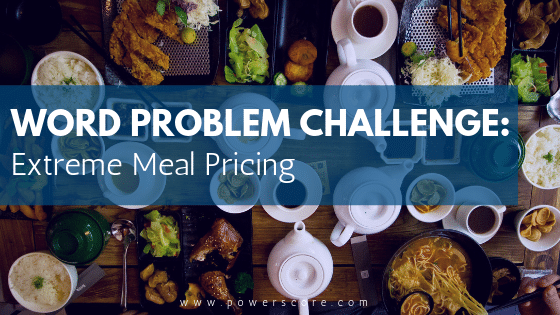GRE word problems sometimes use “real-life settings,” says ETS, to test your quantitative problem solving skills. Talk of salary ranges, fabric purchases, population densities, or similar topics will prompt you to do some algebra or other standard GRE math. Figuring out the math can be tough, given that word problems can be a bit convoluted. For practice, try this word problem that’s likely to stump 4 in 5 test takers.
Difficulty Level: 5 (Very High)
Word Problem, Real-Life
The Challenge
In The Official Guide to the GRE, Practice Test 1 includes a question about the price of a book and the sales tax collected. (See §5, 15.) Only 18% of examinees got the question right when it was on a real exam. Here’s a very similar problem that throws in a service charge along with the sales tax.
The total amount that Dan paid for a meal was equal to the base price of the meal plus a 4% sales tax and a 5% service charge, each of which were applied to the base price of the meal. Dan paid for the meal with a $10 bill and received the correct change, which was less than $3.00. Which of the following statements must be true?
Indicate all such statements.
- The base price of the meal was less than $9.10.
- The base price of the meal was more than $6.50.
- The sum of the sales tax and the service charge was less than $0.85.
The Solution
Step 1: Add the tax and service charge percentages.
Each of these two percentages is collected on the base price of the meal, so you can combine them into one percentage. Here’s the math (just to show you why the addition works).
BP ⇒ Base Price of the Meal
- Sales Tax = BP × 0.04
- Service Charge = BP × 0.05
- Sales Tax + Service Charge = (BP × 0.04) + (BP × 0.05) = BP(0.04 + 0.05) = BP × 0.09
Step 2: Maximize the base price of the meal.
Option [A] puts the base price below $9.10. If you show that the base price can equal or exceed $9.10, then you’ll know to eliminate [A]. To start, find the highest possible total. Since Dan paid with a $10 bill and received at least some change, the total amount is at most $9.99. Now, put [A] to the test.
- Max Total = Max BP × 1.09
- $9.99 = Max BP × 1.09
- $9.17 = Max BP
- $9.17 > $9.10
Thus, [A] is incorrect.
Step 3: Minimize the base price of the meal.
Option [B] puts the base price above $6.50. If you show that the base price can equal or fall below $6.50, then you’ll know to nix [B]. First, find the lowest possible total. Because Dan paid with a $10 bill and got less than $3.00 back, the change can’t be more than $2.99, so the total amount is at least $7.01. Now, put [B] to the test.
- Min Total = Min BP × 1.09
- $7.01 = Min BP × 1.09
- $6.43 = Min BP
- $6.43 < $6.50
Thus, [B] is incorrect.
Step 4 (Optional): Maximize the sum of the sales tax and the service charge.
Strictly, this step isn’t required. Once you’ve safely eliminated [A] and [B], you have to pick [C]. Otherwise, you’d leave the question blank!
You can see why [C] must be true, though. The base price of the meal is at most $9.17, and the total amount Dan paid for the meal is at most $9.99. The difference of those two amounts equals the greatest possible sum of the sales tax and the service charge.
- Max Sum of Sales Tax & Service Charge = Max Total − Max BP
- $0.82 = $9.99 – $9.17
- $0.82 < $0.85
Thus, [C] is correct.
In short, you eliminate all but [C] by finding the max and min for the base price of the meal. Both [A] and [B] are wrong since they get those extremes wrong. You can even calculate the correct extremes using just a three-part inequality:
- $7.01 ≤ 1.09BP ≤ $9.99
- $6.43 ≤ BP ≤ $9.17
As you can probably see, this inequality-based approach nicely consolidates much of the work in Steps 2 and 3.
Ready for more? Check out some of the Hardest and Most Tested Math Topics on the GRE.


Leave a Reply
You must be logged in to post a comment.